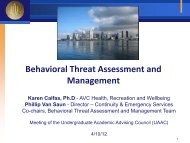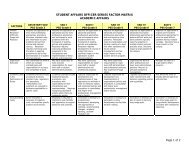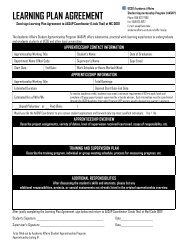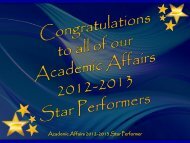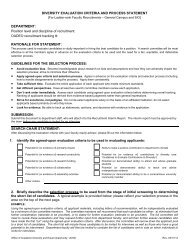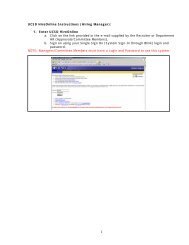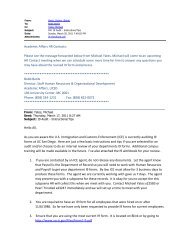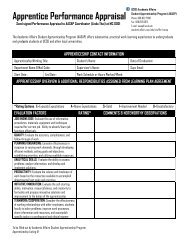Technology Transfer @ UC San Diego - Academic Affairs - UC San ...
Technology Transfer @ UC San Diego - Academic Affairs - UC San ...
Technology Transfer @ UC San Diego - Academic Affairs - UC San ...
You also want an ePaper? Increase the reach of your titles
YUMPU automatically turns print PDFs into web optimized ePapers that Google loves.
<strong>Technology</strong> <strong>Transfer</strong> Office<br />
<strong>Technology</strong> <strong>Transfer</strong><br />
@ <strong>UC</strong> <strong>San</strong> <strong>Diego</strong><br />
BILL ATHING<br />
Finance & Operations Manager - <strong>Technology</strong> <strong>Transfer</strong>
<strong>Technology</strong> <strong>Transfer</strong> Office<br />
Overview of<br />
<strong>UC</strong> <strong>San</strong> <strong>Diego</strong> TTO<br />
<strong>UC</strong>SD TTO<br />
� Brief History<br />
� What we do<br />
� How we do it<br />
� What are the results
<strong>Technology</strong> <strong>Transfer</strong> Office<br />
Brief History of Relevant Laws<br />
� Bayh-Dole Act 1981<br />
� Universities can own and patent fed funded work<br />
� Free license to Feds, march in rights<br />
� Tax-Act<br />
� Sets rules regarding private use of tax-free-bond funded facilities<br />
� Establishes requirement for fair-value of publicly supported<br />
invention and IP<br />
� CA Political Reform Act 1974<br />
� Underlies many COI issues affecting PI’s
<strong>Technology</strong> <strong>Transfer</strong> Office<br />
Bayh-Dole Act, 1980<br />
� The Bayh-Dole Act (Patent and Trademark Act<br />
Amendment, 1980) allowed Universities to retain<br />
title to (own) inventions made under federallyfunded<br />
research<br />
� Act was instrumental in encouraging Universities to<br />
participate in technology transfer activities.<br />
� Universities are encouraged to collaborate with<br />
commercial entities to promote the utilization of<br />
inventions arising from federal funding by licensing<br />
to industry for commercial product development in<br />
the public interest.
WAS THE DESIRED GOAL OF FEDERAL<br />
RESEARCH SPENDING ACHIEVED<br />
� A SIMPLE MEASURE = NEW CONSUMER PROD<strong>UC</strong>TS<br />
� THE ANSWER: NEW PROD<strong>UC</strong>TS WERE NOT COMING OUT<br />
OF THE RESEARCH SPENDING AND WERE IN FACT<br />
HURTING NEW PROD<strong>UC</strong>T DEVELOPMENT<br />
�<br />
<strong>Technology</strong> <strong>Transfer</strong> Office
History of Tech <strong>Transfer</strong><br />
� <strong>UC</strong>OP TTO formed in 1979<br />
� Handled all campus level activity<br />
� 450 miles too far to be effective<br />
� <strong>UC</strong>SD TTO formed 1994 - 2 FTE’s<br />
� 1998-2006 Alan Paau era – growth to 25 FTE’s<br />
� 2006-Present – Jane Moores, AVCIP<br />
<strong>Technology</strong> <strong>Transfer</strong> Office
<strong>Technology</strong> <strong>Transfer</strong> Office<br />
What TTO does<br />
Management of <strong>UC</strong>SD Intellectual Property<br />
� Statutory Protection (patents-new & improved products and<br />
processes with useful application; Copyright-original works of<br />
authorship fixed in tangible medium software, images, films)<br />
� Invention and Copyright Licensing<br />
� <strong>Transfer</strong> of Tangible Materials (if <strong>UC</strong>SD property e.g.<br />
Cell lines, transgenic mice, plasmids)<br />
� Trademarks (related to IP)<br />
Resource & Service Center for Intellectual Property Matters<br />
� Services (to researchers, other administrative departments)<br />
� Education (to <strong>UC</strong>SD faculty, staff & students; other universities)<br />
Outreach (to companies/potential licensees)
Mission Statement<br />
� Promote and facilitate the transfer of <strong>UC</strong>SD<br />
innovations for the benefit of the University<br />
community and the public<br />
� Enhance the research experience of <strong>UC</strong>SD<br />
researchers through technology transfer<br />
� Promote and target regional economic<br />
development by leveraging <strong>UC</strong>SD<br />
innovations<br />
� Provide financial incentives to researchers<br />
to stimulate technological innovations<br />
<strong>Technology</strong> <strong>Transfer</strong> Office
<strong>Technology</strong> <strong>Transfer</strong> Office<br />
<strong>Technology</strong> <strong>Transfer</strong> Process<br />
Evaluation<br />
2,300+<br />
Available<br />
Innovations<br />
Initiate<br />
Patent<br />
Strategy<br />
1,400+<br />
Flow Chart<br />
Marketing<br />
Active Patent<br />
Applications<br />
Reassess<br />
Patent<br />
Strategy<br />
1,500+<br />
Active<br />
Patents<br />
Licensing<br />
License<br />
Compliance<br />
400+<br />
Active<br />
Licenses<br />
Consult<br />
with<br />
Inventor
<strong>Technology</strong> <strong>Transfer</strong> Office<br />
Sample Flow of Invention Income
<strong>UC</strong>SD INVENTION INCOME DISTRIBUTION<br />
<strong>Technology</strong> <strong>Transfer</strong> Office
<strong>Technology</strong> <strong>Transfer</strong> Office<br />
<strong>Technology</strong> <strong>Transfer</strong> in US<br />
Universities - The Environment<br />
Unique Legal, <strong>Academic</strong>, and Political Environment :<br />
� Bayh-Dole Act of 1980 (US)<br />
� Tax Reform Act of 1986 (US - Tax Free Bond Issues)<br />
� Political Reform Act (CA)/Conflict of Interests (US)<br />
� <strong>Academic</strong> Freedom and Integrity Issues<br />
� NIH guidelines<br />
� 9 Points to Consider/University Guidelines<br />
� Missions of the University and its Current Emphasis<br />
� Stakeholders’ Expectations<br />
� Export Regulations
<strong>UC</strong> Guiding Principles in Licensing (2001)<br />
1. Primary objective in developing a licensing strategy for an<br />
invention should be to benefit the public.<br />
2. Licensee should be capable of bringing the invention to the<br />
market.<br />
3. License agreement should include diligence terms that support<br />
the timely development, marketing, and deployment of the<br />
invention.<br />
4. University should receive fair consideration for the grant of<br />
commercial licensing rights.<br />
5. License agreement should support the academic principles of<br />
the University.<br />
8. Licensing decisions based on legitimate institutional academic<br />
& business considerations--not personal financial gain.<br />
<strong>Technology</strong> <strong>Transfer</strong> Office
Nine Points to Consider in Licensing<br />
University <strong>Technology</strong> (March 2007)<br />
� 1. Reserve the right to practice licensed inventions for University and<br />
other non-profit & government organizations<br />
� 2. Exclusive licenses structured in a manner that encourages<br />
technology development and use<br />
� 3. Strive to minimize the licensing of future improvements<br />
� 4. Anticipate and help to manage TT-related conflicts of interest<br />
� 5. Ensure broad access to research tools<br />
� 6. Enforcement action should be carefully considered<br />
� 7. Mindful of export regulations<br />
� 8. Mindful of implications of working with patent aggregators<br />
� 9. Consider including provisions that address unmet needs such as<br />
neglected populations or geographic areas, improved therapeutics,<br />
diagnostic and agricultural technologies for the developing world
Intellectual Property Disclosures<br />
<strong>Technology</strong> <strong>Transfer</strong> Office
<strong>Technology</strong> <strong>Transfer</strong> Office<br />
U.S. Patent Activity
<strong>Technology</strong> <strong>Transfer</strong> Office<br />
Revenue-based Licenses
<strong>Technology</strong> <strong>Transfer</strong> Office<br />
<strong>UC</strong> <strong>San</strong> <strong>Diego</strong> Start-ups<br />
(>130 total)
<strong>Technology</strong> <strong>Transfer</strong> Office<br />
Gross Revenue
Invention (Year disclosed)<br />
<strong>Technology</strong> <strong>Transfer</strong> Office<br />
<strong>UC</strong>SD Top Inventions<br />
Human Cytomegalovirus Diagnostic (SD, 1982)<br />
Radiographic Media (SD, 1979)<br />
Interstitial Cystitis Therapy (SD, 1980)<br />
Egf Receptor Antibodies (SD, 1983)<br />
Firefly Luciferase (SD, 1984)<br />
<strong>UC</strong>-wide<br />
% of Total Income from Top 5 Inventions ~50%<br />
% of Total Income from Top 25 Inventions ~ 75%
License Agreements in FY2009<br />
� Local Impact – National Influence – Global Reach<br />
� More than 400 active license agreements at year<br />
end.<br />
� Highest concentration of licensees are in the state<br />
of California<br />
� One-third of licensees are based in the <strong>San</strong> <strong>Diego</strong><br />
region<br />
<strong>Technology</strong> <strong>Transfer</strong> Office
License Agreements in California (FY2009)
License Agreements in the U.S. (FY2009)
License Agreements Around the World (FY2009)
http://invent.ucsd.edu
Start-ups formed with <strong>UC</strong>SD<br />
<strong>Technology</strong> <strong>Transfer</strong> Office<br />
foundational technology
University of California Top 25<br />
<strong>Technology</strong> <strong>Transfer</strong> Office<br />
FY2009<br />
Invention (Campus, Year Disclosed) Income (in thousands)<br />
Hepatitis-B Vaccine (SF, 1979 and 1981) $15,909<br />
Treatment of Intracranial Aneurysms (LA, 1989) $11,427<br />
Interstitial Cystitis Therapy (SD, 1980) $8,723<br />
Egf Receptor Antibodies (SD, 1983) $5,947<br />
Bovine Growth Hormone (SF, 1980) $5,488<br />
Subtotal (Top Five Inventions) $47,494<br />
Total Income (Top 25 Inventions) $74,698<br />
Total Income (All Inventions) $98,705<br />
% of Total from Top 5 Inventions 48.1%<br />
% of Total from Top 25 Inventions 75.7%
<strong>Technology</strong> <strong>Transfer</strong> Office<br />
� QUESTIONS ????
<strong>Technology</strong> <strong>Transfer</strong> Office
<strong>Technology</strong> Management Strategy<br />
� Our baseball philosophy:<br />
� get “at bat” as often as possible<br />
� Program Implementation:<br />
� Equal access by active marketing broadly<br />
� Partnership in spirit by risk and benefit sharing<br />
� Low entry hurdles to encourage all players<br />
� Reasonable royalty when product is sold<br />
� Diligent performance and patent cost requirements<br />
� Transparency - Sample agreements on web site<br />
<strong>Technology</strong> <strong>Transfer</strong> Office
Ways to Partner with the University<br />
� Licensing<br />
� inventions<br />
� tangible materials<br />
� copyrights<br />
� Research<br />
� sponsored research/collaborations<br />
� research centers<br />
� Joint grant submissions<br />
� <strong>UC</strong> discovery grants<br />
� SBIR/STTR
<strong>Technology</strong> <strong>Transfer</strong> Office<br />
<strong>UC</strong> Guiding Principles in Licensing<br />
(Dec 2000, Revised Oct 2001)<br />
1. Primary objective in developing a licensing strategy for an invention<br />
should be to benefit the public.<br />
2. Licensee should be capable of bringing the invention to the market.<br />
3. License agreement should include diligence terms that support the<br />
timely development, marketing, and deployment of the invention.<br />
4. University should receive fair consideration in exchange for the grant<br />
of commercial licensing rights.<br />
5. License agreement should support the academic principles of the<br />
University.<br />
6. Licensing activities should be carried out within delegated authority.<br />
7. License agreement should be approved for legal integrity and<br />
consistency.<br />
8. Licensing decisions should be based upon legitimate institutional<br />
academic & business considerations--not on personal financial gain.
<strong>Technology</strong> <strong>Transfer</strong> Office<br />
<strong>UC</strong> Guiding Principles<br />
in Licensing<br />
(Dec 2000, revised Oct 2001)<br />
1. The primary objective in developing a licensing<br />
strategy for an invention should be to benefit the<br />
public.<br />
2. The licensee selected should be capable of bringing<br />
the invention to the marketplace.<br />
3. The license agreement should include diligence<br />
terms that support the timely development,<br />
marketing, and deployment of the invention.<br />
4. The University should receive fair consideration in<br />
exchange for the grant of commercial licensing<br />
rights.
<strong>Technology</strong> <strong>Transfer</strong> Office<br />
<strong>UC</strong> Guiding Principles<br />
in Licensing<br />
5. The license agreement should support the academic<br />
principles of the University.<br />
6. Licensing activities should be carried out within<br />
delegated authority.<br />
7. The license agreement should be approved as to<br />
legal integrity and consistency.<br />
8. All decisions made about licensing University<br />
inventions should be based upon legitimate<br />
institutional academic and business considerations<br />
and not upon matters related to personal financial<br />
gain.
IRS Requirements: tax act<br />
� Tax exempt bonds are committed to be used for<br />
“governmental purposes” i.e. related to university’s mission<br />
of education, research and public service<br />
� The IRS limits the amount of “private business use” of<br />
facilities financed with tax-exempt bonds, including research<br />
facilities<br />
� For each bond issue, no more than 5%/10% of the bond<br />
proceeds (up to $150M bond issue) may be used for private<br />
business use<br />
� Research agreements with private companies can create<br />
private use if they have certain characteristics but there is a<br />
safe harbor provision
<strong>Technology</strong> <strong>Transfer</strong> Office<br />
Bayh-Dole Act Provisions<br />
� University can elect to own titles to inventions that<br />
arise from work with federal government funding<br />
� Preference for small businesses<br />
� Preference for US manufacture<br />
� Royalty-sharing with inventors<br />
� Residual revenues must be used to support research and<br />
educational activities<br />
� Confirmatory paid-up NXL to Govt to practice invention<br />
� Government has “march-in” rights<br />
� No assignment of titles to third parties w/o approval<br />
� Reporting requirements
<strong>UC</strong> Guiding Principles & Commitments in<br />
<strong>Technology</strong> <strong>Transfer</strong> Office<br />
Interactions with Industry<br />
1. Open dissemination of research results<br />
2. Commitment to students<br />
3. Accessibility for research purposes<br />
4. Public benefit<br />
5. Informed participation<br />
6. Legal integrity and consistency<br />
7. Fair consideration for university & public<br />
8. Objective decision-making
Nine Points to Consider in Licensing<br />
University <strong>Technology</strong> (March 2007)<br />
� 1. Reserve the right to practice licensed inventions for University and<br />
other non-profit & government organizations<br />
� Preserve ability of all universities to perform research (including research<br />
sponsored by commercial entities) and publish results of research<br />
� Recitals<br />
� Reservation of rights<br />
� 2. Exclusive licenses structured in a manner that encourages<br />
technology development and use<br />
� Necessity for significant investment of time & resources may require<br />
exclusive license. Don’t grant overly broad rights (all fields of use). All<br />
uses may not be appreciated at time of initial licensing.<br />
� Exclusive in limited field<br />
� Diligent development (termination or NXL if not met)<br />
� Recovery of unused fields after certain period<br />
� Mandatory sublicenses
Nine Points to Consider…..<br />
3. Strive to minimize the licensing of future improvements<br />
� Enslave a faculty member’s research program to the licensee. Can<br />
reach through to other faculty. Limit to inventions dominated by<br />
original licensed patents.<br />
� …continuations-in-part (but only to the extent the claims thereof are<br />
enabled by disclosure of the parent application)….<br />
4. Anticipate and help to manage technology transfer-related<br />
conflicts of interest<br />
� Especially a problem for faculty start-ups but also if have interest in<br />
any potential licensee<br />
� TT100. Statement of Economic Interest; position (management,<br />
employee, officer, advisor), investment/equity (or spouse or child) worth<br />
>$ , income (loan gift, consulting) within last year >$<br />
� Licensing officer conflicts
Nine Points to Consider…….<br />
5. Ensure broad access to research tools<br />
� Consistent w/ NIH guidelines, charitable foundations, mission of<br />
university, publication requirements<br />
� Non Exclusive License<br />
� XL for sale, but not use, of patented technology<br />
� 6. Enforcement action should be carefully considered<br />
� Primary mission is to use patents to promote technology<br />
development for the benefit of society. Litigation seldom the<br />
preferred option.<br />
� Contractual or ethical obligations to protect rights of existing licensees<br />
� Blatant disregard of infringer for University’s rights—won’t take<br />
reasonable licensee
Nine Points to Consider…..<br />
7. Mindful of export regulations<br />
� Federal laws governing how information, technologies and<br />
commodities can be transmitted overseas to anyone (including US<br />
citizens) or to a foreign national on US soil (deemed export).<br />
� Fundamental research exclusion can be affected if license conf info’<br />
� Check if license w foreign company<br />
� Licensee agrees to observe all Us and foreign laws wrt transfer of LP<br />
and technical information<br />
8. Mindful of implications of working with patent aggregators<br />
� Good patent aggregators--add value by advancing technology or<br />
overcoming legal barriers (freedom to operate)<br />
� Bad patent aggregators (patent trolls)—extracts payments in absence of<br />
any enhancement to licensed technology
Nine Points to Consider…..<br />
9. Consider including provisions that address unmet needs such as<br />
neglected populations or geographic areas, improved<br />
therapeutics, diagnostic and agricultural technologies for the<br />
developing world<br />
“Universities should strive to construct licensing arrangements in<br />
ways that ensure that [] underprivileged populations have low- or no-cost<br />
access to adequate quantities of [] medical innovations.”<br />
“Licensing activities alone,, without significant added funding, can,<br />
at most, enhance access to medicines for which there is a demand in<br />
wealthier countries. Diseases that afflict only the global poor have long<br />
suffered from a lack of investment in R &D: the prospects of profit do not<br />
exist to draw commercial development, and public funding for diseases<br />
suffered by those who live far away form nations that can afford it is<br />
difficult to obtain and sustain.”
<strong>Technology</strong> <strong>Transfer</strong> Office



